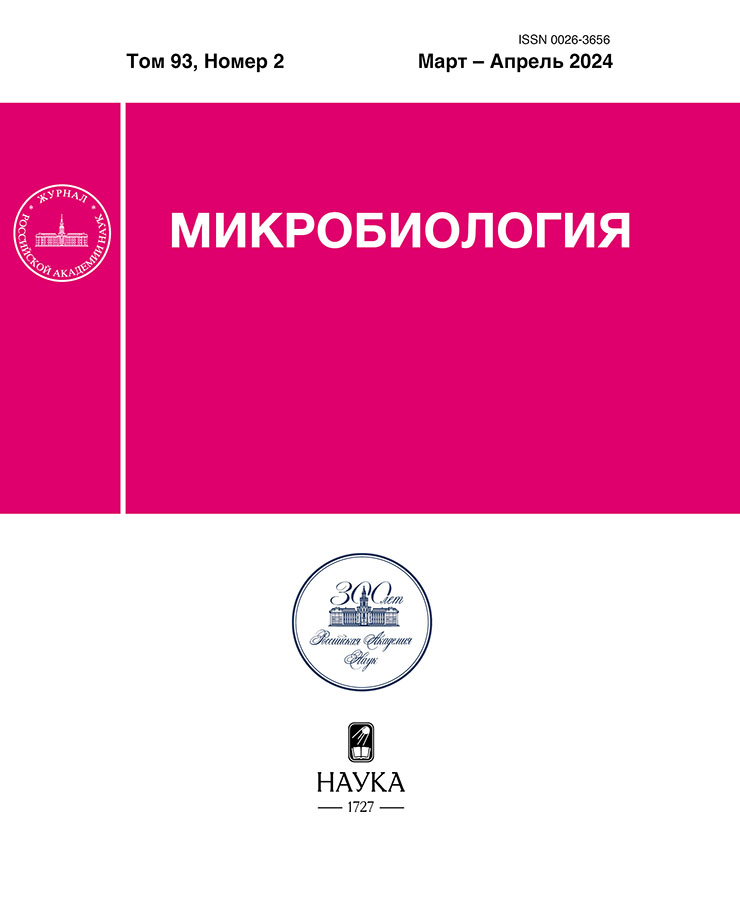Biofilms from the Kapova Cave Walls as a Source of Hydrolase Producers
- Authors: Kurdy W.1, Yakovleva G.Y.1, Ilyinskaya O.N.1
-
Affiliations:
- Kazan (Volga Region) Federal University
- Issue: Vol 93, No 2 (2024)
- Pages: 154-158
- Section: SHORT COMMUNICATIONS
- URL: https://jdigitaldiagnostics.com/0026-3656/article/view/655127
- DOI: https://doi.org/10.31857/S0026365624020101
- ID: 655127
Cite item
Abstract
The studies of bacterial communities from extreme econiches are presently aimed mainly at analyzing the biodiversity of microorganisms using molecular biology methods. Cultivated bacteria from karst caves represent a unique group of microorganisms, the biochemical potential of which has been poorly studied. In the present work, bacteria from biofilms on the walls of the Kapova Cave (Shulgan-Tash Nature Reserve, Bashkortostan) were isolated and characterized in order to assess the ability of identified isolates to produce extracellular hydrolytic enzymes. Most of the isolates (89%) were members of the phylum Proteobacteria, with the remaining ones belonging to the phyla Actinobacteria, Firmicutes, and Bacteroidetes, which accounted for 5, 4, and 2% of the isolates, respectively. Strains with high levels of secreted protease, RNase, and amylase activity were identified as Stenotrophomonas rhizophila, Lysinibacillus fusiformis, and Pseudomonas stutzeri, respectively.
Keywords
Full Text
About the authors
W. Kurdy
Kazan (Volga Region) Federal University
Email: yakovleva_galina@mail.ru
Russian Federation, Kazan, 420008
G. Yu. Yakovleva
Kazan (Volga Region) Federal University
Author for correspondence.
Email: yakovleva_galina@mail.ru
Russian Federation, Kazan, 420008
O. N. Ilyinskaya
Kazan (Volga Region) Federal University
Email: yakovleva_galina@mail.ru
Russian Federation, Kazan, 420008
References
- Галимзянова Н.Ф., Гильванова Е.А., Рябова А.С., Гуватова З.Г., Кудрявцева А.В., Мелентьев А.И. Филогенетическое разнообразие прокариотов в микробных сообществах скальных поверхностей пещеры Шульган-Таш (Капова), южный Урал // Экобиотех. 2020. Т. 3. № 3. С. 298–304.
- Ahamada Rachid N., Doğruöz Güngör N. Major impacts of caving activities on cave microbial diversity: case study of Morca Cave, Turkey // Int. Microbiol. 2023. V. 26. P. 179–190.
- Gopinath S.C., Anbu P., Arshad M.K., Lakshmipriya Т., Voon С.H., Hashim U., Chinni S.V. Biotechnological processes in microbial amylase production // Biomed. Res. Int. 2017. Art. 1272193. https://doi.org/10.1155/2017/1272193
- Holmes A.J., Tujula N.A., Holley M., Contos A., James J.M., Rogers P., Gillings M.R. Phylogenetic structure of unusual aquatic microbial formations in Nullarbor caves, Australia // Environ. Microbiol. 2001. V. 3. P. 256‒264.
- Ilinskaya O.N., Shah-Mahmud R.S. Ribonucleases as antiviral agents // Mol. Biol. 2014. V. 48. P. 615–623.
- Ilinskaya O.N., Singh I., Dudkina E., Ulyanova.V, Kayumov A., Barreto G. Direct inhibition of oncogenic KRAS by Bacillus pumilus ribonuclease (binase) // Biochim. Biophys. Acta. 2016. V. 1863 (7 Pt A). P. 1559‒1567.
- Leuko S., Koskinen K., Sanna L., D’Angeli I.M., De Waele J., Marcia P., Moissl-Eichinger C., Rettberg P. The influence of human exploration on the microbial community structure and ammonia oxidizing potential of the Su Bentu limestone cave in Sardinia, Italy // PLoS One. 2017. V. 12. Art. e0180700.
- Lich N.Q., Thao T.T. P., Huy N.D. Characterization of extracellular protease from Stenotrophomonas rhizophila MT1 isolated from aquaculture sludge waste // Appl. Ecol. Environ. Res. 2022. V. 20. P. 2409–2423.
- Mitkevich V.A., Pace C.N., Koschinski A., Makarov A.A., Ilinskaya O.N. Cytotoxicity mechanism of the RNase Sa cationic mutants involves inhibition of potassium current through Ca2+-activated channels // Mol. Biol. 2015. V.49. P. 933–938.
- Reddy L., Wee Y.-J., Yun J.-S., Ryu H.-W. Optimization of alkaline protease production by batch culture of Bacillus sp. RKY3 through Plackett–Burman and response surface methodological approaches // Bioresour. Technol. 2008. V. 99. P. 2242–2249.
- Schabereiter-Gurtner C., Saiz-Jimenez C., Piñar G., Lubitz W., Rölleke S. Phylogenetic diversity of bacteria associated with Paleolithic paintings and surrounding rock walls in two Spanish caves (Llonín and La Garma) // FEMS Microbiol. Ecol. 2004. V. 47. P. 235–247.
- Schmidt J., John M. Starch metabolism in Pseudomonas stutzeri. I. Studies on maltotetraose-forming amylase // Biochim. Biophys. Acta. 1979. V. 566. P. 88–99.
- Shah Mahmud R., Mostafa A., Müller C., Kanrai P., Ulyanova V., Sokurenko Y., Dzieciolowski J., Kuznetsova I., Ilinskaya O., Pleschka S. Bacterial ribonuclease binase exerts an intra-cellular anti-viral mode of action targeting viral RNAs in influenza a virus-infected MDCK-II cells // Virol. J. 2018. V. 15. Art. 5.
- Shah Mahmud R., Müller C., Romanova Y., Mostafa A., Ulyanova V., Pleschka S., Ilinskaya O. Ribonuclease from Bacillus acts as an antiviral agent against negative- and positive-sense single stranded human respiratory RNA viruses // Biomed. Res. Int. 2017. Art. 5279065.
- Surchenko Y.V., Dudkina E.V., Nadyrova A.I., Ulyanova V.V., Zelenikhin P.V., Ilinskaya O.N. Сytotoxic potential of novel bacillary ribonucleases balnase and balifase // BioNanoSci. 2020. V. 10. P. 409‒415.
- Zhang Z., Schwartz S., Wagner L, Miller W. A greedy algorithm for aligning DNA sequences // J. Comput. Biol. 2000. V. 7. P. 203–214.
- Zhou J.P., Gu Y.Q., Zou C.S., Mo M.H. Phylogenetic diversity of bacteria in an earth-cave in Guizhou province, southwest of China // J. Microbiol. 2007. V. 45. P. 105–112.
Supplementary files












